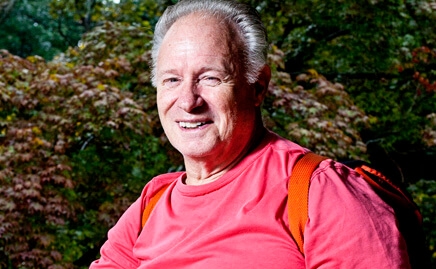"When I talk about the rehab program, I refer to it as the best kept secret in the area. I wouldn’t go anywhere else."

In August 2011, George Scherer climbed Mount Washington. The hike, at just under 4 miles, has a vertical climb of more than 3,000 feet — a challenge for someone at any fitness level.
George was not your average hiker on the mountain that day. Just six weeks prior, George finished physical therapy at RWJ Hamilton’s rehabilitation facility in Ewing following bilateral knee replacement surgery.
Better Living Through PT
“I discovered Robert Wood Johnson physical therapy after rotator cuff surgery on my shoulder a few years ago. When I talk about the rehab program, I refer to it as the best kept secret in the area. I wouldn’t go anywhere else,” says George.
For someone like George, rehabilitation built his strength and has helped him reach his goals. About a year after conquering Mount Washington, George completed a 72.2 mile hike of New Jersey’s Appalachian Trail.
“George is a great example of how physical therapy helps people get back to their daily life and the things they love — pain free,” says RWJ Hamilton physical therapist Dave Alexander, MPT. Dave worked closely with George for both his shoulder rehabilitation and recovery after his knee replacement.
Many patients, like George, come to RWJ for physical therapy for one area of the body and return for rehabilitation on another. Pain and limited mobility — such as George’s shoulder and knees — are typically caused by arthritis, injury, or simple wear and tear, and physical therapy helps to strengthen or retrain problem areas.
“It’s a compliment when a patient returns because it means they liked their experience and are happy with their results,” says George. “Often times we’ll treat families because one patient will refer others.”
A Personal Approach
For each patient, the experience starts with a comprehensive evaluation by a certified physical therapist.
“Everyone’s pain tolerance, functional levels and goals are different, so we adjust treatments as needed,” says Dave.
“Our therapists are trained to explain what’s being done and why. We know that by educating patients and discussing our treatment plan and techniques, we can offer reassurance and guidance.”
One example of a technique used at RWJ to treat patients is manual therapy. This hands-on approach may include soft tissue massage, stretching and working to bend and straighten weak joints. Our physical therapists explain to their patients that the manual therapy technique helps the therapist “feel” limitations and note progress.
“Working with Dave was a really great experience. He really knows his patients and the right exercises for them. He challenges you in the right ways and helps you get to your goals,” says George.